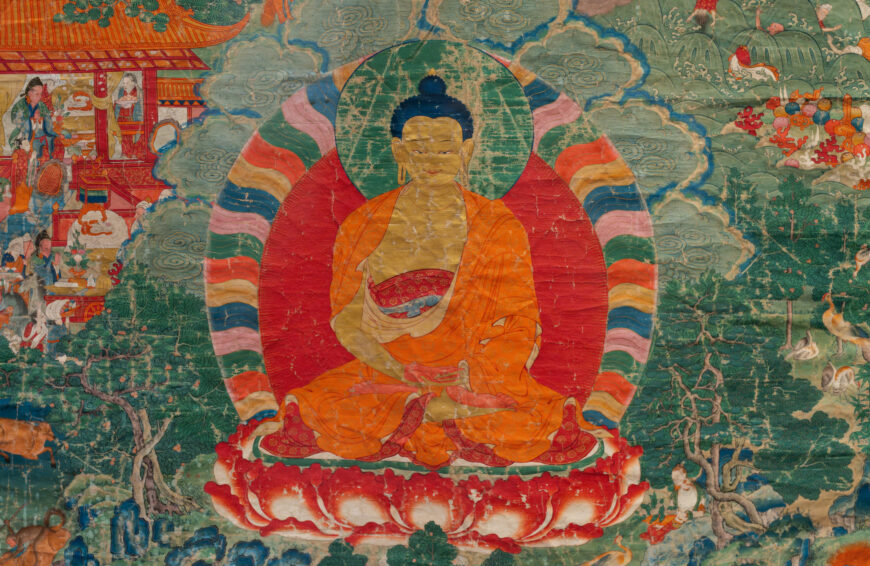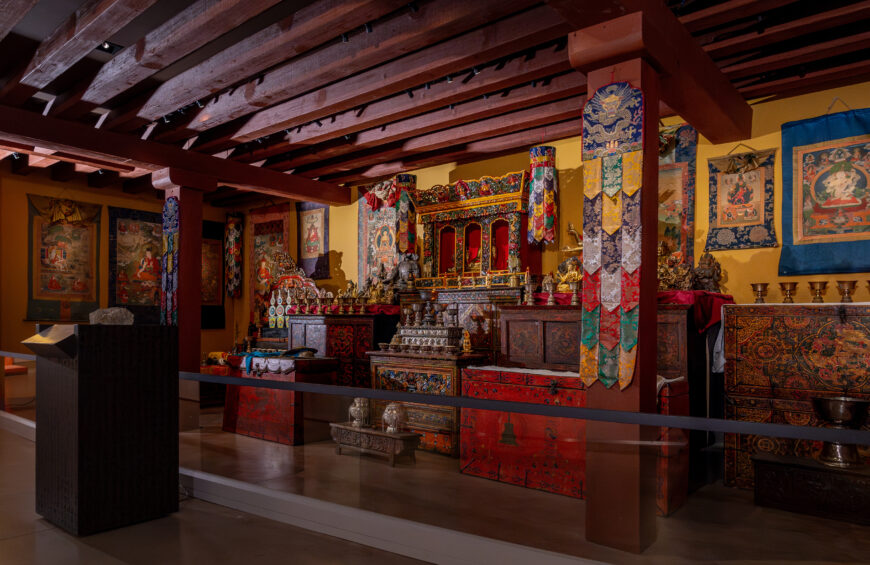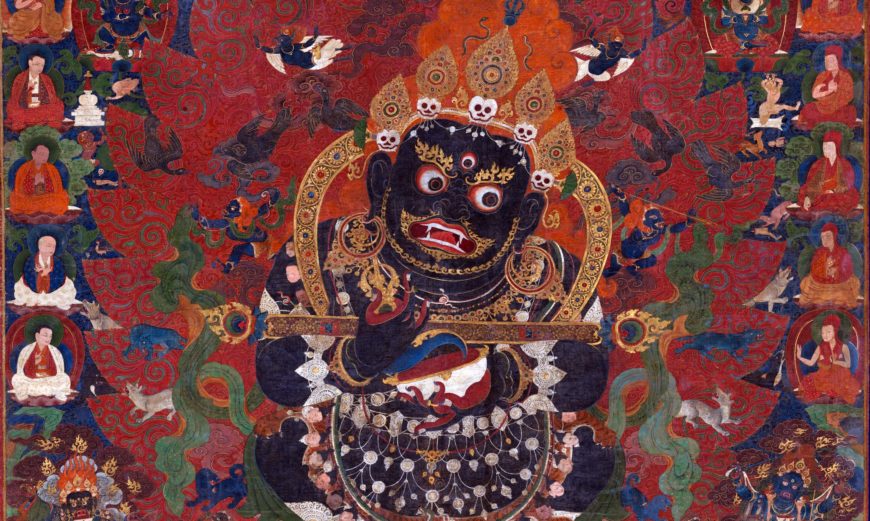Each perfectly geometric, these mandalas are a graphic representation of the Buddhist conception of the cosmos.
Wangguli and five additional Newar artists, Four Mandalas of the Vajravali Cycle (Ewam Choden Monastery, Tsang Province, Central Tibet), 1429–56, pigments on cloth, 88.9 x 73.7 cm; Rubin Museum of Himalayan Art; C2007.6.1 (HAR 81826). Speakers: Dr. Karl Debreczeny, Senior Curator, Rubin Museum of Himalayan Art and Dr. Steven Zucker
In Buddhism, a mandala refers to a cosmic abode of a deity, usually depicted as a diagram of a circle with an inscribed square that represents the deity enthroned in their palace. Mandalas are used by Buddhist practitioners for visualization during meditation. The Rubin’s Senior Curator Dr. Karl Debreczeny and Smarthistory’s Dr. Steven Zucker delve into one of the most important paintings in the Rubin’s collection, Four Mandalas of the Vajravali Cycle.
The Rubin Museum of Himalayan Art has teamed up with Smarthistory to bring you an “up-close” look at select objects from the Rubin’s preeminent collection of Himalayan art. Featuring conversations with senior curators and close-looking at art, this video series is an accessible introduction to the art and material culture of the Tibetan, Himalayan, and Inner Asian regions. Learn about the living traditions and art-making practices of the Himalayas from the past to today.
[music]
0:00:07.2 Dr. Steven Zucker: We’re at the Rubin Museum of Himalayan Art looking at a magnificent example of Tibetan visual art. This is Four Mandalas of the Vajravali cycle. It dates to the 15th century.
0:00:19.0 Dr. Karl Debreczeny: So this is one of the most important, well studied, and well documented paintings in the Rubin Museum collection. And it depicts four mandala. The Sanskrit word mandala in Tibetan dkyil ‘khor means circle with a center, or center and periphery, and by extension, a deity and their retinue.
0:00:36.9 Dr. Steven Zucker: Mandalas are used in the practice of visualization during meditation, it’s a kind of graphic representation of the Buddhist conception of the cosmos, and it’s made of perfect geometries, a perfect square within a perfect circle.
0:00:51.8 Dr. Karl Debreczeny: In each mandala, you have a deity sitting in the center surrounded by their retinue.
0:00:57.3 Dr. Steven Zucker: And if you look closely, you can see that there are four gates.
0:01:00.1 Dr. Karl Debreczeny: And each gate marks a quadrant, which represents a particular element, a cardinal direction, and a Buddha that represents a specific enlightened quality.
0:01:10.0 Dr. Steven Zucker: We are seeing an enormous number of figures here drawn from a text that was made in India several hundred years before this painting was made, which is called the Vajravali.
0:01:20.5 Dr. Karl Debreczeny: There’s an inscription which tells us this is the 13th painting in a set of Vajravali paintings. The Vajravali was a compendium of esoteric teachings compiled in India in the 11th century and widely transmitted in Tibet, and is one of the early attempts to systematize and provide iconographic guides for very complex mandalas used in various tantras. An inscription identifies this as being a commission to fulfill the wishes of Lama Sabzang Papka, which allows us to trace this painting to a set commissioned by the founder of Ngor Monastery, Ngorchen Kunga Zangpo, one of the great artistic patrons in memory of his deceased teacher, Sabzang Papka Zhonnu Lodro, around the timing of the founding of Ngor Monastery in 1429 or shortly afterwards.
0:02:09.1 Dr. Steven Zucker: And to me it’s incredible that we have literal resources that actually speak to this particular set of paintings.
0:02:16.0 Dr. Karl Debreczeny: Ngorchen was one of the main students of Sabzang Papka, and he received the Vajravali cycle of teachings from him. So there’s a connection between the commissioning in memory of his teacher and the subject matter. Ngorchen’s biographer provides very specific details for the set’s creation. Soon after, Ngorchen had the thought of commissioning a complete set of the mandalas of the Vajravali. Six new art painters, including the famous painter Wangguli, and his brother showed up one day at Ngor without any prior arrangements.
0:02:46.8 Dr. Steven Zucker: So the Newar are the original inhabitants of the Kathmandu Valley and were revered for their metalworking and especially for their painting.
0:02:56.4 Dr. Karl Debreczeny: One of the artists recalled that this group had suddenly decided to come to Tibet to the son of Lama Pakpa (meaning Ngorchen), and along the way they were given many better offers to paint, including to be paid in gold. However none of the artists took an interest in this, they were drawn to the remote hermitage of Ngor, and I quote, “as if summoned by the power of Lama Kunga Zangpo’s meditation.” Ngorchen’s biographer concludes that the Newar artists have been summoned to Ngor against their will by the power of Ngor’s protective deities. This represents the culmination of Newar artisanship in Tibet, and its refinement can be seen in the precision and the various delicate scrolling patterns filling the background, the very powerful and dominant red palette, and the arcades with lotus columns along the top row, as well as, for instance, the shape of the stupa on Marichi’s chariot indicate that these were done by Newar artists.
0:03:53.7 Dr. Steven Zucker: Let’s take a close look at one of the mandalas.
0:03:56.9 Dr. Karl Debreczeny: At the center of the mandala is the primary deity. In this mandala, we have Marichi, the goddess of the dawn, being pulled on her chariot of seven sows, or pigs. Around her is her retinue, and the walls of her palace, and each cardinal direction is marked by a gate, and the entire mandala is circumscribed by layers of lotus petals, vajras, and flames.
0:04:25.1 Dr. Steven Zucker: The innermost circle defines a form that looks very much like a stupa, and if you look closely, you can see two eyes, very much in the style that you would recognize on stupas from the Kathmandu Valley, and so a further reference to the origins of the artist. That stupa is bound by these beautiful garlands that fall down on either side and then contained within a white field with this very delicate scroll work.
0:04:53.8 Dr. Karl Debreczeny: When a practitioner is visualizing themselves as the deity, for instance, in deity yoga, where the objective is to take on the enlightened qualities of the deity depicted, one actually moves through a three-dimensional space.
0:05:09.3 Dr. Steven Zucker: So this is not simply a painting, it’s not simply a set of iconographies, it is also a map that we are meant to understand ourselves moving through.
0:05:17.4 Dr. Karl Debreczeny: It’s a two-dimensional rendering of a three-dimensional architectural space.
0:05:20.6 Dr. Steven Zucker: But this painting is not a single mandala. It’s actually four principle mandalas, each filled with its own iconography.
0:05:27.6 Dr. Karl Debreczeny: In the left, we have the Vajradhatu, or diamond sphere mandala, with Vairochana at the center. At the top right, we have the Durgati-parishodhana mandala, which comes from the Sarva Durgati Parishodhana Tantra, or the elimination of all bad rebirths, which is especially important for funerary rituals. And at the center, you have a form of Buddha Shakyamuni, who’s understood here to be a form of Vairochana. At the bottom left, you have Bhutadamara, who is a form of Vajrapani, who subdues elemental spirits. And in the bottom right, you have Marichi, goddess of the dawn.
0:06:05.7 Dr. Steven Zucker: Each of these four mandalas are completely uniquely constructed, and when we look at the other surviving paintings from this series, we see that there is no replication, that each of these is completely unique.
0:06:19.1 Dr. Karl Debreczeny: And then along the top, there are the 16 bodhisattvas of the fortunate eon, and our eon is considered fortunate because this is the eon that the Buddha appeared in. And each of them is color-coded to the direction of the mandala they’re associated with.
0:06:33.9 Dr. Steven Zucker: But we have a second row of figures down at the bottom of the painting.
0:06:37.1 Dr. Karl Debreczeny: And the bottom, there are 16 gatekeepers of the Saravid Vairochana mandala or the all-knowing Buddha.
0:06:43.5 Dr. Steven Zucker: When I stand back and look at these four principle mandalas and all of the figures, there is a kind of optical dynamism that comes from the scroll work, comes from the color, and simply comes from the complexity of the image. But there’s also a geometric rigor that creates a sense of clarity and stability. And that stability is especially enhanced by the crossed Vajras that underlie each of the four principle mandalas.
0:07:09.8 Dr. Karl Debreczeny: Cross Vajras is a symbol of unshakable stability.
0:07:12.7 Dr. Steven Zucker: And a reminder that this is based on the Vajravali, which translated literally means diamond garland.
0:07:20.6 Dr. Karl Debreczeny: A garland of vajras, as this is a part of a compendium of many different teachings.
[music]





